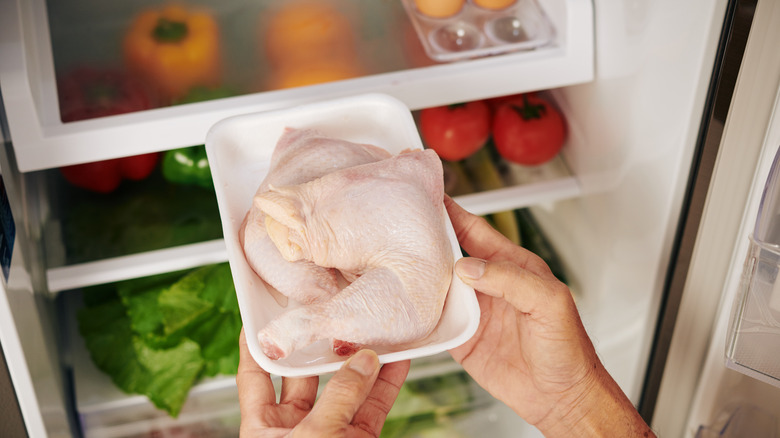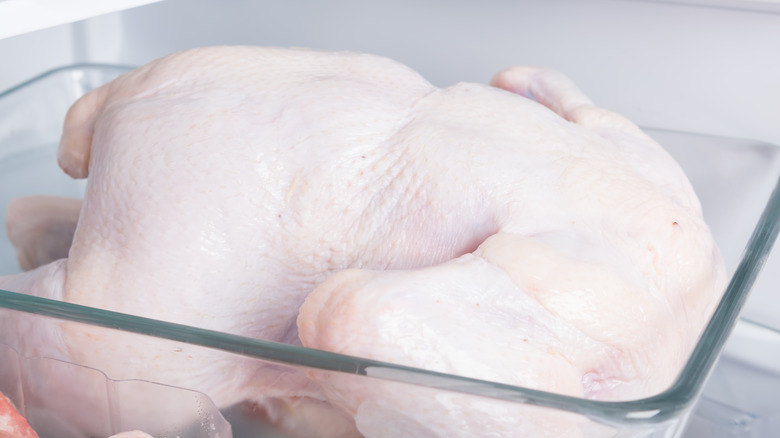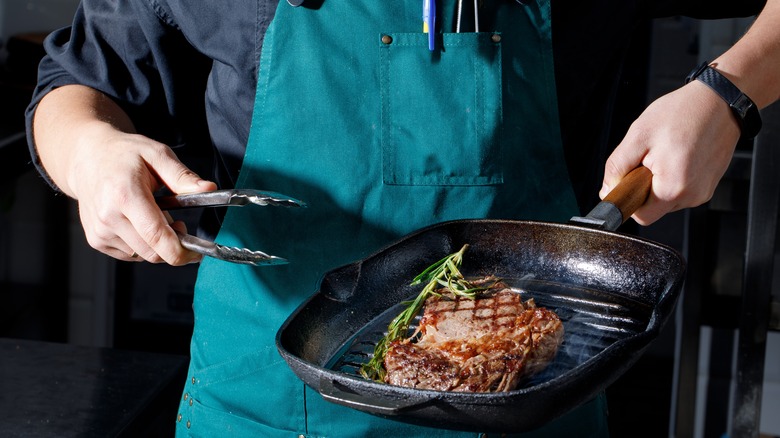Air Drying Is A Foolproof Way To Make Restaurant Quality Meat At Home
What makes the expensive meat dish at restaurants so good? Sure, the people who prepared it are professional chefs, but the secret's also in the meat itself, which can be improved by a simple technique that coaxes optimal qualities out of even the humblest cuts. While steaks chilling in cold cases or carcasses hanging look dramatic, they're both just serving to dry age the meat. America's Test Kitchen explains that this process turns the proteins in the meat into peptides and amino acids, while enzymes naturally tenderize it. The results are more tasty and tender than non-dry aged meat.
While fresh might seem best for meat, Meathead's AmazingRibs.com reports that "green" beef from a very recently-slaughtered animal has not had time to relax, so it's tougher. It can also have a bland, iron kind of taste — while the aged stuff is markedly richer (per Jess Pryles). But according to Jess Pryles, there are also drawbacks to dry aging — in addition to a significant time investment, you will have to contend with mold, shrinkage, and meat loss due to the necessity of trimming off the toughened, unappetizing outermost layer of the meat. Also, dry-aged meat can be more expensive, and doing it yourself takes time and patience, and there might be mold to deal with. Consider a faster, more approachable technique: Air drying.
A simple way to make meat even better
To see air drying in action on a large scale, check out Alton Brown's spatchcocked roast turkey recipe – the whole bird is butterflied, seasoned (dry brined), and refrigerated uncovered for four days. This helps the skin dry out so it can crisp up to a beautiful golden brown later, per New York Times Cooking. It'll also work for small cuts like steaks, as America's Test Kitchen demonstrates. So why do this? Drier meat browns more efficiently, yielding a superior crust when cooked. Michael Ruhlman and Brian Polcyn note in their book "Charcuterie: The Craft of Salting, Smoking, and Curing," that drying also helps form a pellicle, "a tacky surface that the smoke will stick to," which is practical advice for those who grill or cure their meats (via Cook's Illustrated).
To start, pat your meat dry and wrap it lightly in cheesecloth so it retains some moisture. Place the meat on a wire rack over a baking sheet to catch the blood, and put the whole setup where your fridge is most cold, typically the back of the bottom shelf, and leave it for three days. However, America's Test Kitchen notes that you'll want to maintain a constant temperature to slow any unwanted bacterial growth in your air-drying meat, which means don't do it in the fridge that you frequent constantly. Opening the door will disrupt the condition you're trying to create.
More on air drying and cooking air dried meat
Try air drying with Alton Brown's dry-aged chimney porterhouse. He wraps steaks in paper towels on a rack in a sheet pan and lets them chill for a whole day. Afterward, you replace the paper towels and keep the steak in the fridge for three more days, refreshing the wrapping if they get clingy and soggy. Brown lets the unwrapped steak come to temperature for an hour and seasons it thirty minutes before cooking. While air drying will not create the same nuanced, umami flavors and textures in your meat that dry aging does, sources concur that you'll notice a significant difference when you cook air dried meat. Try it with your next steak dinner or experiment with different cuts, wild game, or lean options like bison, goat, and rabbit.
You can also air dry poultry. Let it sit for a few days in the fridge to use for soups, salads, and other dishes. If you don't have the fridge space for a whole spatchcocked bird, why not start small with roasted Cornish hens with orange-mustard glaze? With so many recipes and choices available, the home cook (and their guests) will be able to experience the delicious effects of air drying without the significant space and time investment of dry aging.


